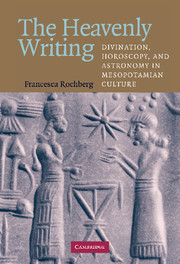Book contents
- Frontmatter
- Contents
- Preface
- Acknowledgments
- Abbreviations
- Chronological References and Akkadian and Astronomical Terminology
- The Heavenly Writing
- Prologue
- 1 The Historiography of Mesopotamian Science
- 2 Celestial Divination in Context
- 3 Personal Celestial Divination: The Babylonian Horoscopes
- 4 Sources for Horoscopes in Astronomical Texts
- 5 Sources for Horoscopes in the Early Astrological Tradition
- 6 The Scribes and Scholars of Mesopotamian Celestial Science
- 7 The Classification of Mesopotamian Celestial Inquiry as Science
- Epilogue
- Bibliography
- Name Index
- Subject Index
6 - The Scribes and Scholars of Mesopotamian Celestial Science
Published online by Cambridge University Press: 08 January 2010
- Frontmatter
- Contents
- Preface
- Acknowledgments
- Abbreviations
- Chronological References and Akkadian and Astronomical Terminology
- The Heavenly Writing
- Prologue
- 1 The Historiography of Mesopotamian Science
- 2 Celestial Divination in Context
- 3 Personal Celestial Divination: The Babylonian Horoscopes
- 4 Sources for Horoscopes in Astronomical Texts
- 5 Sources for Horoscopes in the Early Astrological Tradition
- 6 The Scribes and Scholars of Mesopotamian Celestial Science
- 7 The Classification of Mesopotamian Celestial Inquiry as Science
- Epilogue
- Bibliography
- Name Index
- Subject Index
Summary
The rich source material for the activities of scribes in the Neo-Assyrian court makes it clear that the scribal personnel of the palace, those involved in celestial and other divinatory sciences, participated in a complex of relationships that were at once political and religious. By the fourth century b.c., however, evidence for the intense involvement of the king with the scholars appears to diminish. To say that cultural and intellectual change is shaped by political and social change is perhaps true, but in the present context, none too clear. At the end of the Neo-Babylonian dynasty, the fall of Babylonia in 539 b.c. to Achaemenid King Cyrus II certainly affected Mesopotamian politics and society, but what the nature of these changes may have been for the intellectual elite is difficult to identify. One determinable change in the environment of later Babylonian scholarship was the shift of the locus of astronomical activity from the palace to the temple. When exactly this occurred, however, is not well documented. Only limited Achaemenid evidence is so far available for the association of the scholars with the temple. Although the astronomical diaries testify to the continuous activity of astronomy in Babylon from the eighth century b.c., concrete support for identifying the temple Esagila as the provenance of the diaries comes only in the Arsacid period.
- Type
- Chapter
- Information
- The Heavenly WritingDivination, Horoscopy, and Astronomy in Mesopotamian Culture, pp. 209 - 236Publisher: Cambridge University PressPrint publication year: 2004

